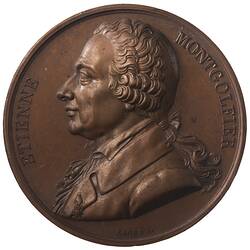The Montgolfier brothers (Joseph Michel & Etienne Jacques) from Annonay, near Lyons, France, experimented with hot air balloons made from paper, silk and linen in the late 18th century. Their family trade was papermaking and this skill allowed them to construct the lightweight envelope required to achieve lift. After a series of public demonstrations at Avignon and Annonay in 1782-83 with unmanned balloons, the interest of the Academie des Sciences and King Louis XVI was aroused. At a demonstration flight before the Court at Versailles on 19 September 1783, a sheep, a rooster and a duck were placed in a wicker basket suspended beneath a decorative hot air balloon and released to complete an eight minute free-flight which ended in a forest just over one mile away. Apparently this experiment was intended to observe the effect of altitude on the creatures, although logic would suggest that the duck would already have been familiar with the concept of flight.
The first manned balloon flight took place on 15 October 1783 when J.F. Pilatre de Rozier ascended in a tethered balloon made from linen and painted blue and yellow, decorated with the twelve signs of the zodiac and portraits of Louis XVI. This balloon was then used for the first manned free-flight of a balloon on 21 November 1783 when de Rozier and the Marquis d'Arlandes left the Bois de Boulogne on a flight which took them over Paris for nearly six miles at about 300 feet. A fire suspended under the envelope was fed with straw. The Marquis had to douse several small spot-fires around the circular basket with a damp sponge.
In January 1784 a larger Montgolfier cotton and paper composite balloon (named 'Le Flesselles') reached a height of around 3000 feet at Lyons carrying seven people including Joseph Montgolfier and members of the nobility.
More Information
-
Keywords
-
Localities
-
Authors
-
Article types


